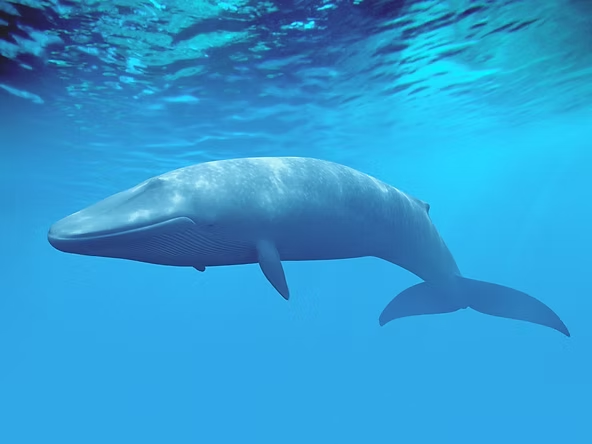Blue Whales: Giants of the Ocean
The blue whale is the world’s largest animal, weighing up to 200 tons. Its heart is the size of a Volkswagen Beetle, and its stomach can hold about one ton of krill. To survive, a blue whale consumes roughly four tons of krill per day. These whales are also the loudest animals on the planet, with calls reaching 188 decibels—louder than a jet engine. Their low-frequency whistles, audible over hundreds of kilometers, are likely used for communication and attracting mates.
Appearance and Coloring
- Blue whales appear blue underwater, but their surface pigmentation is mottled blue-gray.
- Their underbellies often appear yellowish due to millions of skin-dwelling bacteria.
- They have a large, flat head and a long, tapering body ending in wide, triangular flukes.
Behavior and Vocalization
- Blue whales are found in all oceans except the Arctic, usually swimming alone or in pairs.
- They feed in polar seas during summer and migrate toward equatorial waters as seasons change.
- They normally cruise at over 5 mph but can reach speeds over 20 mph when disturbed.
- Blue whales produce groans, pulses, and moans; their calls can travel up to 1,000 miles under ideal conditions.
Longevity
Blue whales are long-lived animals, with lifespans averaging 80–90 years. The oldest recorded individual, determined from earplug layers, was approximately 110 years old.
Distribution and Habitat
- Blue whales inhabit all oceans except the Arctic, migrating between summer feeding grounds and winter breeding sites.
- They are most common where krill are abundant; distribution varies by food availability.
- North Atlantic populations range from the southern hemisphere to the Greenland Sea, with sightings off eastern Canada and the U.S. East Coast.
- East North Pacific whales spend winters near Mexico and Central America, feeding in summer along the U.S. West Coast, Gulf of Alaska, and central North Pacific.
- Calving and nursing occur in the Gulf of California from December through March.
Conservation
- Blue whales were heavily hunted for whale oil in the 1900s, with over 362,000 killed by the mid-1960s.
- They received international protection in 1966, but populations have recovered only slightly since then.
- Predators are rare but include sharks and killer whales; ship collisions also cause deaths annually.

